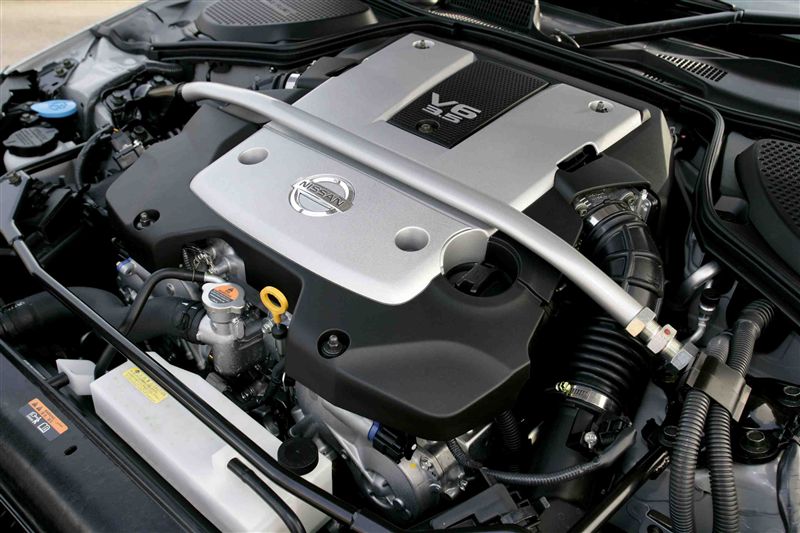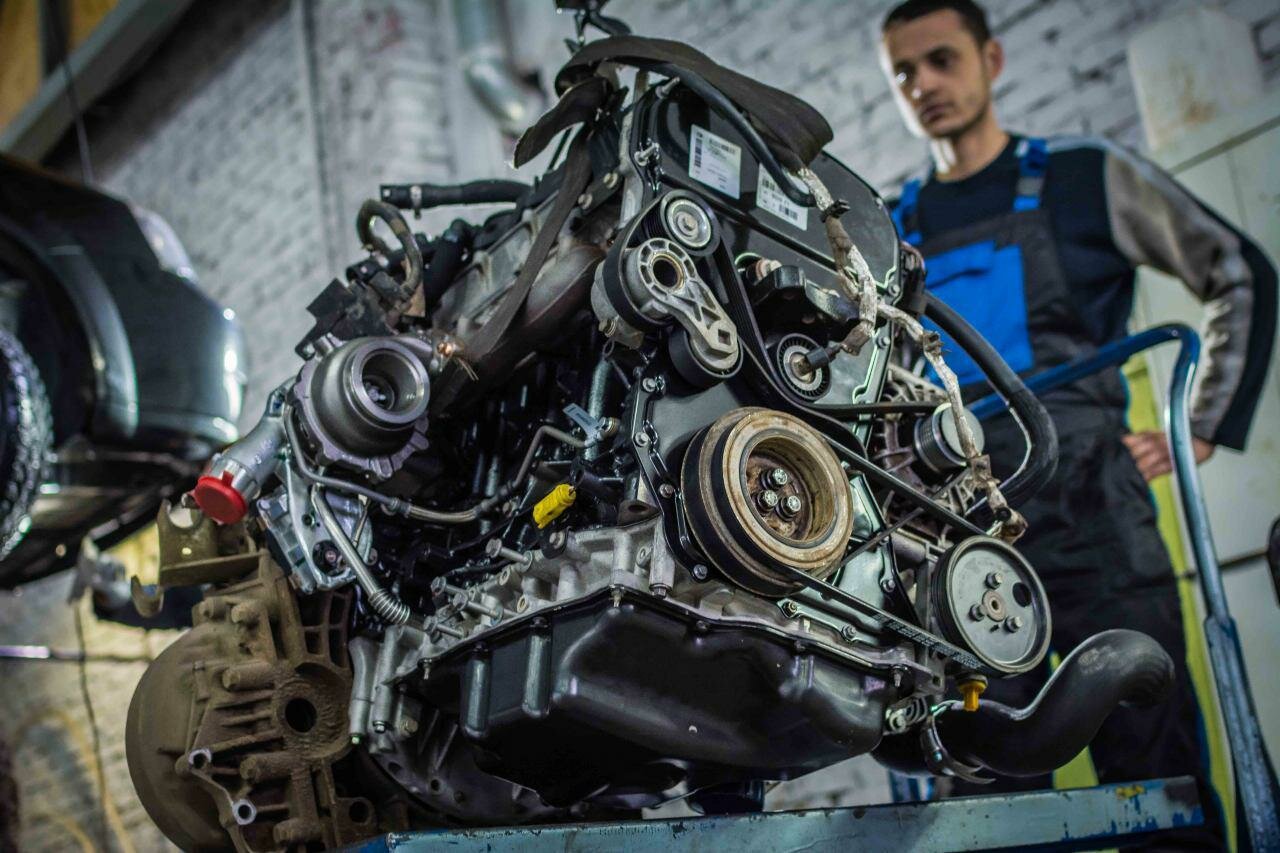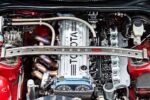The Nissan VQ35HR engine is a 3.5-liter V6 engine that was introduced in 2007 as a successor to the VQ35DE engine. It was used in several Nissan and Infiniti models, including the Nissan 350Z, Infiniti G35, G37, and M35, as well as the Nissan Altima and Murano.
The VQ35HR engine features several improvements over its predecessor, including a higher redline, increased horsepower, and improved fuel efficiency. It also features a new dual-intake system, revised exhaust system, and new camshaft profiles that provide improved performance and throttle response.
The VQ35HR engine was designed to meet stricter emissions regulations and improve fuel efficiency. It features Nissan’s Variable Valve Event and Lift (VVEL) technology, which improves engine efficiency and performance by adjusting valve lift and timing according to driving conditions. The VVEL system also improves fuel efficiency by reducing pumping losses and improving combustion efficiency.
Engine specifications for Nissan VQ35HR 3.5 l
| Configuration | V |
| Number of cylinders | 6 |
| Number of valves | 24 |
| Displacement | 3498 cc |
| Cylinder diameter | 95.5 mm |
| Stroke | 81.4 mm |
| Power system | Injector |
| Engine power | 300 – 315 hp |
| Torque | 340 – 365 Nm |
| Compression ratio | 10.6 |
| Fuel type | Medium/Plus |
| Emissions standard | EURO 4/5 |
The dry weight of the VQ35HR engine is 190 kg
The VQ35HR engine number is located at the junction of the block with the box
Fuel consumption for the Nissan VQ35HR
The fuel consumption specifications for the VQ35HR engine:
| City Fuel Economy | 19-20 mpg |
|---|---|
| Highway Fuel Economy | 26-27 mpg |
| Combined Fuel Economy | 22-23 mpg |
| Fuel Type | Premium unleaded gasoline (91 octane minimum) |
Note that these fuel consumption specifications may vary depending on the specific year, model, and driving conditions of the vehicle. Additionally, modifications and aftermarket parts can also affect fuel consumption. These values are based on estimates from the United States Environmental Protection Agency (EPA).
What cars have the Nissan VQ35HR
| G35 4 (V36) | 2006 – 2009 |
| Q50 1 (V37) | 2013 – 2018 |
| EX35 1 (J50) | 2007 – 2012 |
| FX35 2 (S51) | 2008 – 2012 |
| M35 3 (Y50) | 2008 – 2010 |
| M35h 4 (Y51) | 2011 – 2013 |
| Q70 1 (Y51) | 2013 – 2019 |
| 350Z 5 (Z33) | 2006 – 2009 |
| Cima 5 (Y51) | 2012 – 2020 |
| Fuga 1 (Y50) | 2007 – 2009 |
| Fuga 2 (Y51) | 2010 – … |
| Skyline 12 (V36) | 2006 – 2008 |
| Skyline 13 (V37) | 2014 – … |
| Dignity 2 (Y51) | 2012 – 2016 |
VQ35DE vs VQ35HR
The comparison table between the VQ35DE and VQ35HR engines:
| Specification | VQ35DE | VQ35HR |
|---|---|---|
| Engine Type | V6, naturally aspirated | V6, naturally aspirated |
| Displacement | 3.5 liters (3498 cc) | 3.5 liters (3498 cc) |
| Bore x Stroke | 95.5 mm x 81.4 mm | 95.5 mm x 81.4 mm |
| Compression Ratio | 10.3:1 | 10.6:1 |
| Horsepower | 287-300 hp @ 6,200 rpm | 306-306 hp @ 6,800 rpm |
| Torque | 274-260 lb-ft @ 4,800 rpm | 268-274 lb-ft @ 4,800 rpm |
| Valvetrain | Double overhead camshaft (DOHC), 4 valves per cylinder | Dual overhead camshaft (DOHC), 4 valves per cylinder |
| Fuel System | Sequential multi-port fuel injection (SFI) | Sequential multi-port fuel injection (SFI) |
| Ignition System | Electronic ignition (EI) | Electronic ignition (EI) |
| Lubrication System | Wet sump | Wet sump |
| Cooling System | Water-cooled | Water-cooled |
| Engine Materials | Aluminum block and cylinder heads | Aluminum block and cylinder heads |
| Maximum RPM | 6,500 | 7,500 |
| Redline | 7,000 | 7,500 |
| Fuel Type | Premium unleaded gasoline (91 octane minimum) | Premium unleaded gasoline (91 octane minimum) |
| Oil Capacity | 4.5 quarts (with filter change) | 5.0 quarts (with filter change) |
| Recommended Oil | 5W-30 or 10W-30 synthetic blend | 5W-30 or 10W-30 synthetic blend |
| Recommended Coolant | Ethylene glycol-based coolant, mixed 50/50 with water | Ethylene glycol-based coolant, mixed 50/50 with water |
| Emissions Control | Three-way catalytic converter, oxygen sensors | Three-way catalytic converter, oxygen sensors |
| Transmission | 6-speed manual or 5-speed automatic | 7-speed automatic or 6-speed manual |
| Applications | Nissan 350Z, Infiniti G35 | Nissan 350Z, Infiniti G35, G37, FX35, EX37 |
Note that these specifications may vary slightly depending on the specific year and model of the vehicle. Overall, the VQ35HR engine offers higher horsepower and torque than the VQ35DE engine, as well as a higher redline and larger oil capacity.
Nissan VQ35HR 3.5l Maintenance
| Interval | every 10 000 km |
| Oil capacity | 5.3 l |
| Need to change | 4.9 l |
| Type of oil | 5W-30, 5W-40 |
| Timing Chain Type | Timing Chain |
| Service life | not limited |
| In practice | 100 000 – 150 000 miles |
| At breakage/trans-skip | Bending of valves |
| Adjustment | every 100 000 km |
| Intake | 0.26 – 0.34 mm |
| Exhaust | 0.29 – 0.37 mm |
| Air filter | 30 000 km |
| Fuel filter | 120 000 km |
| Spark plugs | 30 000 km |
| Drive belt | 120 000 km |
| Coolant | 5 years or 100 000 km |

Common Problems with the Nissan VQ35DE Engine
The Nissan VQ35DE engine, a 3.5L V6 engine, has been in use for over two decades. Nissan has continued to use it for this long because it provides a balance of performance, reliability, and longevity. This article discusses the three most common problems associated with the VQ35DE engine: high oil consumption, timing chain/tensioner, and oil leaks.
It is important to note that these issues are only the most common, not necessarily affecting a significant percentage of engines. They are also not major problems and do not indicate that the VQ35DE engine is unreliable. However, when failures do occur, these are the most common areas.
-
High Oil Consumption
The VQ35DE engine has a reputation for burning oil at a fast rate, especially with age and higher mileage. However, this does not usually cause reliability concerns. There are no underlying problems that cause higher oil consumption, and it does not cause any other problems for the engine.
It is important to pay attention to oil levels and top up between oil changes. If oil consumption becomes too excessive, it may be necessary to investigate the issue further. This is especially true if it is accompanied by excess smoke from the exhaust. High-quality oils, avoiding excessive idling, and shortening the OCI can help reduce oil consumption.
-
Timing Chain Failures
The timing chain guides and tensioners are two of the most common problems associated with the VQ35DE engine. These parts help keep tension and guide the timing chain and are critical to the engine’s timing chain system. If these parts are not addressed in time, they can cause damage to the timing chain itself.
Symptoms of timing chain problems include rattling or clunking noises from the engine bay, a check engine light, and power loss. Checking the timing chain around the 150,000-mile mark is good maintenance, as problems usually show up after 100,000 miles.
Replacing the guides and tensioners on the VQ35DE engine is a moderately intensive labor job that costs around $500-800, depending on location and year/model. Parts usually come in around $100-400. We recommend replacing the full system with a timing chain kit, especially if the engine is high mileage and you intend to keep the car.
-
Oil Leak Problems
As VQ35DE engines age, they can develop oil leaks from the valve cover gaskets (VCG). The VQ35DE engine is not alone in this problem as valve cover leaks are common on many engines. The valve cover gaskets are made from rubber material and undergo a lot of stress from constant heat cycles, which cause them to degrade and begin cracking over time.
Oil leaks from the valve cover gaskets are usually not an urgent repair, but they will continue to get worse over time as existing cracks expand and more develop. The main concern is oil dripping onto hot components, causing fire or safety hazards. Valve cover leaks may cause oil to leak onto other engine parts like engine mounts, causing premature wear.
Symptoms of oil leaks from the VQ35DE valve cover gaskets include visible leaks, burning oil smells, and smoke from the engine bay. VCG replacement is not a challenging DIY job, but labor expenses can add up at a repair shop.
Overall, the VQ35DE engine is reliable and earns above-average marks for reliability. Regular maintenance and timely repairs will ensure a reliable and long life of 200,000+ miles.
Tuning
The detailed table outlining the different types of tuning available for the Nissan VQ35HR engine, along with the approximate horsepower gains and costs associated with each type of tuning:
| Type of Tuning | Horsepower Gain | Cost |
|---|---|---|
| Air Intake | 5-10 hp | $200-$500 |
| Exhaust System | 10-15 hp | $500-$1,500 |
| ECU Remapping | 15-25 hp | $500-$1,500 |
| Forced Induction (Turbo or Supercharger) | 50-200+ hp | $5,000-$10,000+ |
| Fuel System Upgrades | 10-25+ hp | $1,500-$3,500 |
| Engine Build | 200-500+ hp | $10,000-$20,000+ |
Again, it’s worth noting that these horsepower gains and costs are approximate and can vary depending on various factors such as the specific parts used, the quality of the installation, and the tuning expertise of the mechanic or tuning shop. Additionally, some types of tuning may require additional upgrades or modifications in order to maximize their horsepower gains or reliability.
Supercharger kit VS Turbo kit
The differences between a supercharger kit and a turbo kit for the Nissan VQ35HR engine, including cost:
| Feature | Supercharger Kit | Turbo Kit |
|---|---|---|
| Type of Forced Induction | Positive Displacement | Exhaust Gas Driven |
| Power Delivery | Immediate and Linear | Delayed and Boost-Dependent |
| Installation Complexity | Easier, Bolt-On | More Complex, Custom Fabrication Required |
| Cost | $5,000-$10,000+ | $4,000-$8,000+ |
| Maintenance | Low Maintenance, Oil Changes | Moderate Maintenance, Oil Changes and Periodic Inspection of Exhaust System |
| Reliability | Generally More Reliable | Generally Less Reliable |
| Sound | Whine or Whistle | Hiss or Whistle |
| Fuel Efficiency | Decreased Fuel Efficiency | Decreased Fuel Efficiency |
| Horsepower Gains | Up to 150+ hp | Up to 200+ hp |
Please note that these costs are approximate and can vary widely depending on the specific components used, the quality of the installation, and the tuning expertise of the mechanic or tuning shop. Additionally, these costs may not include additional modifications or upgrades that may be required to support the added horsepower from the forced induction system.
Top views |
|
|---|---|
 |
Oil, Timing Chains, Pistons: What Really Kills an Engine Prematurely? |
 |
How to Choose a Car with a Reliable Engine: Used Car Market Hacks That Actually Work |
The approximate prices for a Nissan VQ35HR engine:
| Condition | Price Range |
|---|---|
| Brand New | $3,500-$5,500 |
| Remanufactured | $2,500-$4,500 |
| Used, Low Mileage | $1,500-$3,500 |
| Used, High Mileage | $500-$1,500 |
Please note that these prices are approximate and can vary widely depending on various factors such as the specific year and model of the engine, the condition of the engine, and the location and availability of the engine. Additionally, the cost of installation and any necessary modifications or upgrades are not included in these prices. It’s important to thoroughly research and inspect any engine before purchasing to ensure its quality and suitability for your needs.




0 Comments